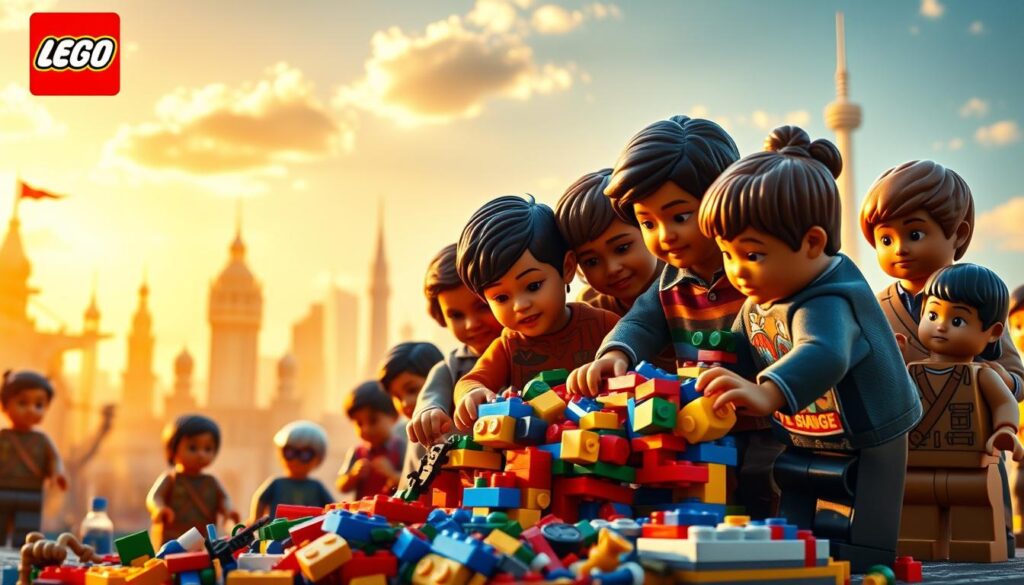
Did you know that over 100 million people worldwide engaged with the Rebuild the World campaign, making it one of the most viewed campaigns in history? This revolutionary movement, launched in 2019, has redefined the way we think about play and creativity, impacting both children and adults globally.
The campaign’s core message revolves around the idea that creativity has no limits. By transforming everyday objects into imaginative creations, it encourages everyone to embrace their inner child and explore the endless possibilities of play. Whether it’s a knight building a bridge or a rabbit outsmarting a hunter, the narrative is filled with humor and wit, making it relatable and engaging for all ages.
Through innovative visual storytelling and strategic partnerships, the campaign has successfully positioned the LEGO brand as a leader in inspiring creativity and innovation. It’s not just about building with bricks; it’s about fostering a skill that’s essential in today’s fast-changing world.
With its global reach spanning cinema, digital platforms, and out-of-home advertising, the campaign has become a benchmark for modern branding. It’s a testament to how creativity can be a powerful tool for growth and innovation. Ready to explore how this campaign has reshaped the world of play and imagination? Let’s dive in.
Learn moreabout how creativity drives innovation.
Origins and Creative Vision
When the Rebuild the World campaign launched in 2019, it entered a market facing significant digital disruptions. Traditional toy markets were struggling to compete with the rise of digital entertainment, and play patterns were evolving rapidly. This shift mirrored broader market changes, where platforms like Myspace failed to innovate, while Facebook thrived by focusing on simplicity and user-centric design.
Market Challenges and Shifts
Digital distractions were altering how children and adults spent their time. The toy industry needed reinvigoration, and the Rebuild the World campaign stepped in to address this challenge. By emphasizing creative thinking, it aimed to inspire both kids and adults, showing that play is not just for children.
Creative Vision and Strategic Partnerships
The campaign’s success hinged on strategic partnerships, including collaborations with creative agencies like BETC Paris. These partnerships brought fresh perspectives, helping to craft a narrative that was both humorous and engaging. The campaign also responded to evolving perceptions of play, encouraging adults to embrace their inner child and explore creative possibilities.
By focusing on simplicity and user-centric approaches, the campaign mirrored the strategies that made platforms like Facebook successful. This approach not only repositioned the brand but also highlighted the importance of creativity in a world increasingly dominated by technology.
Learn more about how strategic partnerships can drive creative reinvention in the toy industry.
Power of the LEGO Rebuild the World Campaign
The Rebuild the World campaign has harnessed the power of visual storytelling to captivate audiences globally. By blending surreal imagery with relatable narratives, the campaign instantly engages viewers, making it a benchmark for modern marketing strategies.
Visual Storytelling and Global Engagement
At the heart of the campaign is a creative narrative featuring a hunter chasing a rabbit in a fantastical LEGO world. This scenario serves as a metaphor for overcoming obstacles with innovative solutions. The campaign’s multi-channel approach, spanning TV, cinema, digital platforms, and interactive installations, ensures its message resonates widely, redefining what play means for all ages.
Driving Brand Perception with Playful Innovation
High-quality visuals and strategic collaborations have elevated the brand, building trust and reinforcing its position as a leader in creative play. The campaign’s ability to empower viewers to see challenges as opportunities for creative problem-solving underscores its impact. By balancing fun with meaningful messages, it appeals to both children and adults, addressing societal themes while promoting imagination.

Learn more about how creative strategies drive innovation in marketing. The campaign’s success sets the stage for understanding how visual narratives contribute to market dominance, much like platforms that thrive through simplicity and user-centric design.
Comparative Analysis: Lessons from Myspace and Facebook
Understanding the rise and fall of social media giants can offer valuable insights into modern marketing strategies. The story of Myspace and Facebook serves as a prime example of how innovation and user experience can make or break a platform.
Myspace’s Missed Opportunities in Innovation
Myspace, once a leading social network, struggled with poor user experience and misguided acquisitions. Its cluttered interface and lack of innovation led to a decline in user engagement. This downfall highlights the importance of adapting to technological shifts and prioritizing user-centric design.
As you reflect on Myspace’s journey, consider this timeline challenge: At what pivotal moments could Myspace have altered its course to remain competitive?
Facebook’s Rise through Simplicity and User Experience
Facebook’s success, on the other hand, was driven by a streamlined approach and focus on intuitive design. By simplifying the user experience and continuously innovating, Facebook became the go-to platform for social interaction. This approach not only enhanced user satisfaction but also set a new standard for social media platforms.
| Platform | Strategy | User Experience | Outcome |
|---|---|---|---|
| Myspace | Outdated strategy, poor acquisitions | Cluttered, complex interface | Decline in user base |
| Emphasis on simplicity and innovation | Intuitive, user-friendly design | Rapid growth and market dominance |
Facebook’s ability to evolve and prioritize user needs is a key lesson for marketers. As explained here, understanding your audience and delivering a seamless experience is crucial for long-term success.
As you consider these lessons, remember that in today’s competitive market, clear messaging and user-centered design are essential. The story of Myspace and Facebook serves as a reminder of the importance of innovation and adaptability in maintaining relevance and engagement.
Conclusion
In a world where creativity knows no bounds, the Rebuild the World campaign has set a new standard for inspiring innovation. By blending humor, relatable narratives, and imaginative visuals, it has reshaped how we view play and creativity. This movement has not only transformed brand perception but also empowered a global community to embrace creative problem-solving.
The campaign’s success offers valuable lessons. It shows how balancing creativity with strategic vision can drive lasting impact. Much like Facebook’s rise to dominance through simplicity and user-centric design, this campaign highlights the power of engaging narratives and visual content in modern marketing.
As you consider these insights, remember the importance of continuous innovation and creative exploration. Whether you’re a marketer, a builder, or a fan of imaginative storytelling, this campaign invites you to rethink how you approach challenges. Join the timeline challenge to revisit key moments in digital evolution and explore how these strategies can shape your own marketing efforts. Together, we can build a future where creativity and balance go hand in hand.

 LEGO’s Rebuild the World Campaign Inspires Creativity and Imagination
LEGO’s Rebuild the World Campaign Inspires Creativity and Imagination
0 Comment